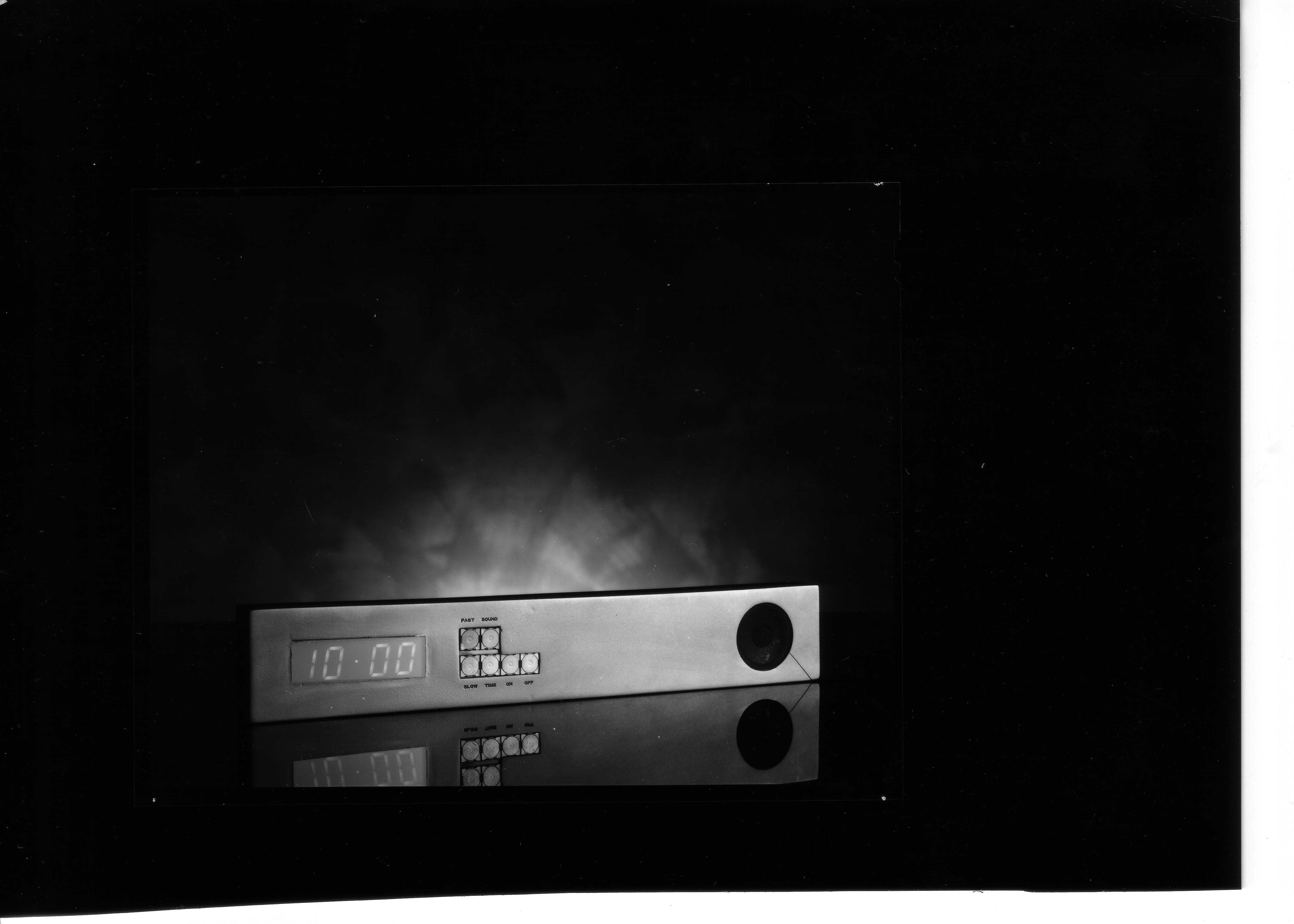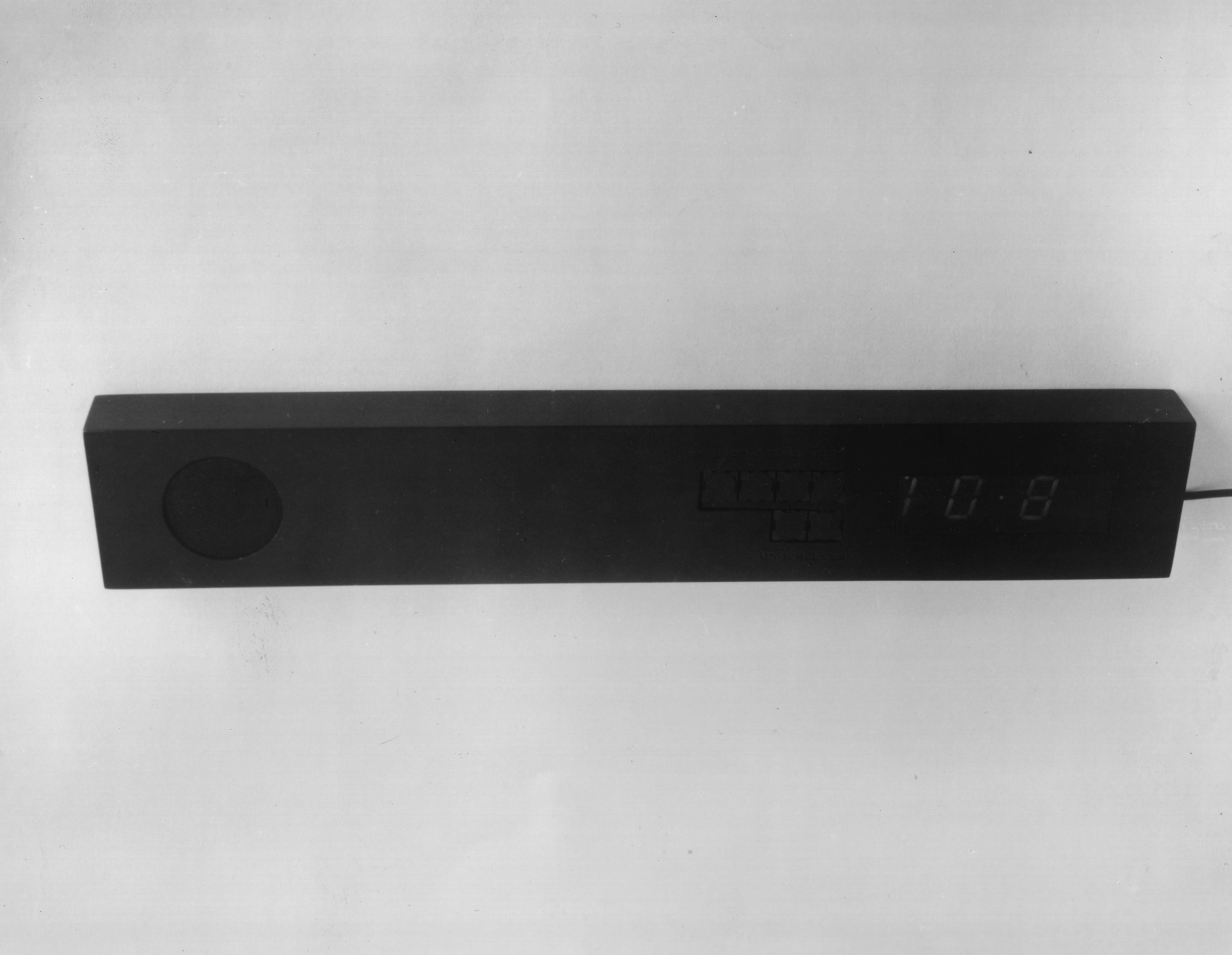1980
TIME PIECE - SILENT ALLARM by Max Neuhaus, 1980
The first work in the series of Time Pieces.
The first work in the series of Time Pieces.

Max Neuhaus's Moment Work commemorates an unusual product that never went into production: a silent alarm clock he designed in 1979. Neuhaus described it as "five by sixteen by one inch, with a time display, buttons on the left side of the longer face, and a round face on the right, behind which a small speaker was concealed." Before the set alarm time, the alarm clock emitted a continuous, low-pitched tone, carefully tuned to the maximum volume audible during sleep without waking the sleeper. Neuhaus explained that this frequency had "a very special quality. It is present, but almost inaudible—more presence than noise." Starting at an almost inaudible volume, the tone gradually increased until it abruptly ceased at the set alarm time. The sudden silence, the absence of auditory stimuli, awoke the sleeper.

Image: Silent Alarm Clock, 1980 © Copyright Neuhaus Estate, piblished in: Max Neuhaus: Times Square – Time Piece Beacon. New York, [editors, Lynne Cooke and Karen Kelly, with Barbara Schröder], Dia Art Foundation. Distributed by Yale University Press., New Haven & London, 2009
* * *
'This work is not a decor, but a ceremony (from carimonia, which in turn comes from careo = to lack, be deprived). It is a way of differing from the tradition. Not fullness of sound, then, but lack or movement in the interval between fullness and emptiness.
In 1979, Max Neuhaus adjusted the alarm clock to the sensibility of the sleeper who wants to wake up at a certain time. He designed a sound that does not disturb sleep, but whose disappearance and subliminal absence strike the sleeper and bring about awakening.
What counts here is not the form or presence of the sound, but its efficacy.'
Gernano Celant
Translated from the Italian by Brian Holmes
Germano Celant, 'Max Neuhaus: An Occasion for Listening', 1994

Photo: published in the Catalog, MULTIPLES, INC. 1965 - 1992.
Edited and Written by Dieter Schwarz, Foreword by Marian Goodman. 2021
A new illustrated essay by Dieter Schwarz and a reprint of an essay by Samuel Wagstaff from an old Multiples catalog.
The bulk of the catalog consists of Dieter's carefully documented chronology of each individual Multiple produced, with selected illustrations.
Co-published with Konig.
* * *
NEUHAUS - TIME PIECE SERIE
SILENT PUBLIC CLOCKS
THE CONCEPT OF USING SOUND TO FORM A COMMON MOMENT WITHIN A COMMUNITY, PERIODICALLY THROUGHOUT THE DAY, IS AN ANCIENT ONE. IT EXISTS IN PRESENT DAY SOCIETY IN THE FORM OF CHURCH BELLS AND PUBLIC CLOCKS.
THE IDEA FOR THE TIME PIECES IS ABOUT FORNING THESE COMMON MOMENTS WITH SILENCE RATHER THAN SOUND.
_______
THE METHOD
THE CONCEPT IS REALIZED BY GRADUALLY CHANGING THE ACOUSTIC ENVIRONMENT, AND THEN CREATING A SENSE OF SILENCE BY REMOVING THESE CHANGES.
A SOUND TEXTURE IS SLOWLY INTRODUCED OVER A PERIOD OF MINUTES SO THAT IT IS NOT NOTICED DIRECTLY, BUT SUBTLY ESTABLISHES A DIFFERENT OR IMAGINARY SENSE OF PLACE, ACOUSTICALLY.
ONCE ESTABLISHED, THIS PLACE IS REMOVED, JUXTAPOSING THE IMAGINARY WITH THE REAL AND EXPOSING THE REAL, IN A NEW WAY, AS A MOMENT OF QUIET.
IT IS IMPORTANT THAT THE SOURCES OF SOUND REMAIN UNSEEN, AND THAT THE WORK BECOMES A COMMON OCCURRENCE
-- A SUBTLE PRESENCE, THERE AND AT THE SAME TIME NOT THERE -- NOTICED, FORGOTTEN .. AND RE-FOUND.
MAX NEUHAUS
Sound WorkAlarm Clock menzioneted in: HMKV_CAG_Besucherinfo_DE_Web.pdf
p.48